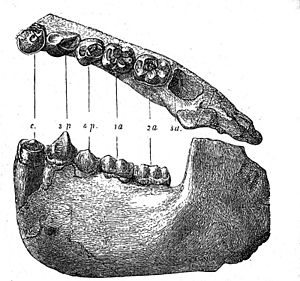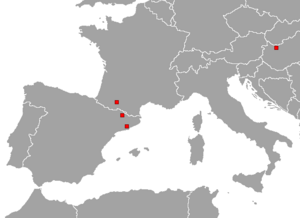Dryopithecus
| Dryopithecus | ||||||||||||
|---|---|---|---|---|---|---|---|---|---|---|---|---|

Pine of Dryopithecus fontani |
||||||||||||
| Temporal occurrence | ||||||||||||
| middle Miocene | ||||||||||||
| 17 to 10 million years | ||||||||||||
| Locations | ||||||||||||
| Systematics | ||||||||||||
|
||||||||||||
| Scientific name | ||||||||||||
| Dryopithecus | ||||||||||||
| Lartet , 1856 | ||||||||||||
| species | ||||||||||||
Dryopithecus is an extinct genus of Old World monkeys that wascommonin Africa , Europe and Asia during the Miocene . Finds from Africa are said to be between 17 and 12 million years old.
After Dryopithecus as was Dryopithecinenmuster described arrangement of the five bumps ( "tubercles" ) on the crowns of the molars named, also in him - or his close relatives - derived, early apes (hominids) is present.
Naming
Dryopithecus is an artificial word . The name of the genus was derived from Édouard Armand Lartet in 1856 from Greek: drys = "oak" and πίθηκος, in ancient Greek pronounced píthēkos = "monkey". Dryopithecus means “monkey from the oak forest” and refers to the discovery of the first fossil at Saint Gaudens ( France ), where oak remains were recovered together with the first fossil find . The epithet of the type species , Dryopithecus fontani , was chosen in honor of the fossil finder, Fontan.
features
The quite numerous finds that were assigned to the genus are mostly individual teeth, mandibular and other bone fragments; a complete skeleton has not yet been found.
It is estimated that Dryopithecus weighed between 18 and 45 kg, depending on the size of the species. A brain volume of approximately 280 to 350 cubic centimeters has been calculated for Dryopithecus brancoi . On the basis of his teeth and other bone finds, it is assumed that Dryopithecus was a forest dweller who lived mainly on trees, rarely came down to the ground and presumably - accessed from the thin enamel - ate mainly fruits, leaves and other soft plant foods. The facial bones of Dryopithecus and in particular its back molars show features that are also found in great apes still alive today, but only in the late Miocene genus Ouranopithecus in other Miocene monkeys . From the finds from Catalonia called Dryopithecus laietanus it is said that the animals of this species were able to move by hand under branches.
The humerus and some other bones of the Dryopithecus skeleton below the head have features similar to those of the gorillas living today. This has also contributed to bringing the genus into close proximity to the ancestors of the great apes. "Most of the morphological matches (...) are, however, not regarded by the majority of authors as synapomorphies , but as homoplasias ", that is, as having arisen several times independently of one another.
Classification in the line of ancestors
The classification of the genus in the family tree of the Old World monkeys is controversial; there are - as with Oreopithecus - two variants:
- Dryopithecus is a genus of human-like (Hominoidea) and part of the family of the apes .
- Dryopithecus forms its own family (Dryopithecidae) and represents a side branch to the development of the great apes.
In 2009 David Begun summarized the genera Dryopithecus , Rudapithecus and Hispanopithecus as well as Ouranopithecus and Graecopithecus in the tribe Dryopithecini .
Numerous finds that were initially made to the genus Dryopithecus were later given other names:
- An upper jaw fragment named in 1915 by Guy Ellcock Pilgrim as Dryopithecus punjabicus is today identified by some experts as Ramapithecus punjabicus and others as Sivapithecus punjabicus .
- The finds, initially identified as Dryopithecus sivalensis , are now placed on Equatorius africanus .
- The finds, initially referred to as Dryopithecus keiyuanensis and later as Ramapithecus keiyuanensis , have been assigned to the genus Lufengpithecus as Lufengpithecus keiyuanensis since 1987 .
Some researchers assume that Dryopithecus and Proconsul are the same genus, which is why z. B. the names Dryopithecus africanus , Dryopithecus major and Dryopithecus nyanzae are synonymous with Proconsul africanus , Proconsul major and Proconsul nyanzae .
literature
- David Begun : A Review of the Genus Dryopithecus. Dissertation, University of Pennsylvania, 1987
- David Pilbeam : Notes on Ramapithecus, the earliest known hominid, and Dryopithecus. In: American Journal of Physical Anthropology , Vol. 25, No. 1, 1966, pp. 1-5
Web links
- Meike Köhler, Salvador Moy Sola: Riddle Dryopithecus. In: Spektrum.de . January 1, 1994 .
- Jussi T. Eronena, Lorenzo Rook: The Mio-Pliocene European primate fossil record: dynamics and habitat tracking. (pdf; 859 kB) In: Journal of Human Evolution . 47, 2004, pp. 323-341 (English).
Individual evidence
- ↑ Édouard Armand Lartet : Note sur un grand singe fossile qui se rattache au groupe des singes supérieurs. In: Comptes rendus de l'Académie des Sciences, Paris. Volume 43, 1856, pp. 219-223
-
^ David R. Begun and László Kordos :: Revision of Dryopithecus brancoi SCHLOSSER, 1901 based on the fossil hominoid material from Rudabánya. In: Journal of Human Evolution. Volume 25, No. 4, 1993, pp. 271-285, doi: 10.1006 / jhev.1993.1049
László Kordos and David R. Begun: A new cranium of Dryopithecus from Rudabánya, Hungary. In: Journal of Human Evolution. Volume 41, No. 6, 2001, pp. 689–700, doi: 10.1006 / jhev.2001.0523 , full text (PDF) - ↑ Josep Fernández de Villalta, Miquel Crusafont : Dos nuevos antropomorfos del Mioceno espanol y su situacion dentro del la moderna sistematica de los simidos. In: Notas Commun. Inst. Geol. Min. , Volume 13, 1944, pp. 91-139 (first description of Dryopithecus laietanus )
- ↑ according to the Paleobiology Database
- ↑ David R. Begun, László Kordos: Cranial evidence of the evolution of intelligence in fossil apes. In: Anne E. Russon, David R. Begun (Eds.): The Evolution of Thought. Evolutionary Origins of Great Ape Intelligence. Cambridge University Press, Cambridge 2004, p. 261, ISBN 0-521-78335-6
- ↑ David R. Begun: European Hominoids. In: Walter C. Hartwig (Ed.): The Primate Fossil Record , Cambridge University Press, 2002, p. 365
- ^ Fiorenzo Facchini : The Origins of Humanity. Konrad Theiss Verlag, Stuttgart 2006, p. 62
- ↑ Winfried Henke , Hartmut Rothe : Stammesgeschichte des Menschen. Springer Verlag, Berlin 1999, p. 62
- ^ David R. Begun : Dryopithecins, de Bonis, and the European origin of the African apes and human clade. In: Geodiversitas , Volume 31, No. 4, 2009, pp. 789–816, full text (PDF; 3.0 MB)
- ↑ Steve Ward, Barbara Brown, Andrew Hill, Jay Kelley, and Will Downs: Equatorius: A New Hominoid Genus from the Middle Miocene of Kenya. In: Science , Volume 285, No. 5432, 1999, pp. 1382-1386, doi : 10.1126 / science.285.5432.1382
- ^ R. Wu: A revision of the classification of the Lufeng great apes. In: Acta Anthrop. Sin. , Vol. 6, 1987, pp. 265-271
